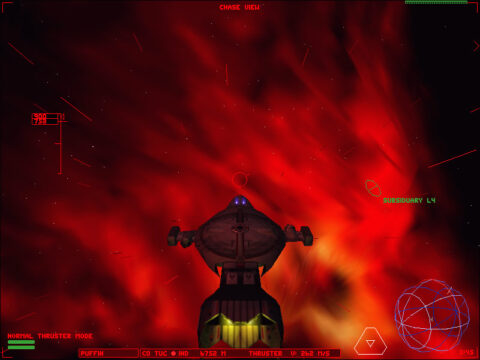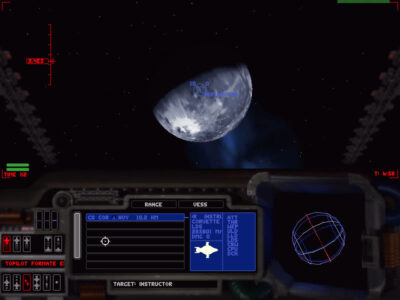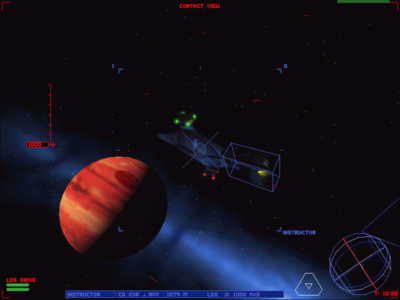
I-War
Written by: Stoo
Date posted: September 3, 2002
- Genre: Simulation
- Developed by: Particle Systems
- Published by: Ocean
- Year released: 1997
- Our score: 8
note – this game was referred to as Independence War in North America.
Now, in terms of outlook this site is not aiming to copy Home of the Underdogs. We’re not strongly dedicated to the forgotten games, because in all fairness many of those deserved to be forgotten. However, every so often I realise that a really great game seems to have gone largely un-noticed by the general gaming community, and I feel I ought to put in a good word for it. A good example of an underrated gem is is I-War, a critically acclaimed starship simulator that sadly gained little attention compared to the likes of the X-Wing series.
So what makes this one so worthy of our consideration today? One aspect where I-War differs from most space-combat games is the flight model – it uses classical Newtonian mechanics to determine how spacecraft should move. You know, force being equal to mass times acceleration, each action having an equal and opposite reaction and so on. Ships have inertia here. I won’t give you a physics lesson, so lets just say that the direction in which you’re moving won’t always be the direction in which the ship’s nose is pointing. If you’re hurtling forwards at a thousand metres per second, and you want to head towards something to your right, then the thrusters take a certain amount of time to adjust your velocity vector; you can’t just turn on a dime. The controls are thus more complex than the simplistic models in such games as Wing commander, but it makes for a far more convincing simulation of an actual spacecraft. Another difference from the norm is that you have command of a 150 metre corvette named Dreadnought, which feels much heavier in terms of responding to the controls than a dinky little fighter. In terms of convenient sci-fi examples: It’s a lot more akin to the motion of, say, Babylon 5’s White Star than an X-wing.
Realism doesn’t always guarantee fun, though – the combat in Frontier (for example) was quite frankly crap. Fortunately there’s a few on-board tricks to help you out. You have the option of computer assistance, which basically tries to keep your ship moving in a ‘forwards’ direction as much as possible pointing by firing various directional thrusters. Normally the assistance lags just a couple of seconds behind your changing orientation, unless you try a really crazy stunt. Generally it’s best to keep this active for most of the time, although by occasionally reverting to unassisted flight in combat you can pull off some handy moves. For example, accelerating towards an enemy starbase, aiming just slightly away so you’ll pass close by without colliding. Then cutting engines so you continue at constant speed, pivoting 90 degrees to your direction of motion (without changing that motion) and strafing across the target’s hull as it passes in front of your field of view. To further aid your manoeuvring are thrusters which can push your ship sideways; this lets you “circle-strafe” an enemy, almost like you might do in an first-person shooter. In other words, there’s more to a dogfight in I-War than the standard fare of space-shooters, which in my experience is constantly pulling tight turns to try and stay on an enemy’s tail.
As you might imagine for a space-based game, you will sometimes need to cover vast distances at high speed, and there’s three ways here to move your ship around. Of course, the old hyperspace trick gets you from one star-system to another in a matter of seconds, whilst for traveling between waypoints within a system there’s an engine called the LDS. This can produce fantastic acceleration to send you to speeds close to that of light itself. Of course, combat wouldn’t be much fun if the bad guys were going so fast that you had half a millisecond to shoot them before they were two thousand kilometres away. Fortunately though when it’s time for some blasting everyone tends to come down to relatively low speeds, traveling under conventional thrusters. Enemy warships are still tricky targets, so to give you an extra hand your cannon are self-aiming within a fire arc of about 15 degrees.
Still, the combat can be very challenging, even in the early missions. A lot of enemy hardware is equal in capabilities to your own, and the computer is a good shot, sometimes suspiciously better than your own auto-aiming. Until you’ve mastered controlling your ship (which takes a while, so be patient), you’ll probably find yourself dying in seconds when caught up in a close-range dogfight. Generally, if the enemy scores more than couple of decent solid hits on you, you’ll find ship’s systems going offline leaving you unable to fire, out of control and possible immobile. At times it’s thus simply far too easy to get blasted to pieces, especially when outnumbered. Of course the answer to this is to diligently practice at combat, and it definitely is rewarding when you realise you’re mastering the various tactics. However failing eleven attempts in a row on a single mission is never fun, and if too much practice is forced on you it starts to feel more like a chore than entertainment . So that’s why (in case you’ve already glanced at the score), despite my enthusiasm for I-war, I can’t quite bring myself to give it top marks.
Back to more positive issues: a nice touch is that you can move around the bridge of your ship to sit in one of four control stations: three let you fly the ship, with an interface more suited to the gunner, pilot or commander, whilst a fourth directs repairs. Again this adds to the feel of flying a large starship. You don’t actually have to be in all four places at once; you’ll probably find yourself flicking between pilot and gunner stations for the most part. There’s also a whole host of autopilot options, which will make your ship follow another, rendezvous at a certain point, dock with something etc. So, during the quiet moments you can usually just sit back and let the ship fly itself. Meanwhile those of you still yearning for a bit of fighter action will be pleased to know that you do occasionally get to pilot one through remote control. The differences in handling are instantly noticeable; the fighter has fantastic acceleration compared to the more Volvo-like corvette. It’s a shame you don’t get to control any more ships though. The blurb in the manual states that the bridge module of your Corvette fits the smaller Gunboats you see cruising around, but this idea never seems to be implemented in the game itself. There’s also a lack of variety in weapons; you have a cannon, a few different kinds of missile and that’s about it. It’s not a huge flaw, just a bit disappointing.
Looking at the overall structure of the game, the layout of missions is fairly linear at heart but not entirely so; at any one time you usually can choose from three or four. Certain missions are integral to the plot and must be completed before new ones become available, whilst others are not obligatory but broaden your experience as a starship captain. The objectives you are set and situations you find yourself in are are certainly varied; along with the usual combat patrols or guarding capital ships, there’s some fairly original ideas. A favourite of mine was the assault on a huge starbase, where you use a bulk freighter as projectile by docking with it and using your own engines to send it hurtling towards the target. Another has you trying to catch incoming containers of volatile antimatter before they strike a vulnerable station.
Just in case you’re wondering, apart from a few missions based around a rather cool first-contact scenario, there isn’t that much in the way of alien-blasting in I-War. The main story behind the game instead revolves around the struggle between the Navy. a terrorist group known as the ‘indies’ (that’s Independents, not bands making terrible lightweight jangly guitar music), and a few other shadowy villains. The story takes quite a few twists and turns along the way, and is interesting enough. To help it along there are also some cracking pre-rendered cutscenes, and the fifteen-minute opening cinematic is especially amazing.
Thinking of possible room for improvement, I suppose with a spacecraft sim, the one extra thing you might want is a slightly more open-ended and non-linear game. There are hints of this if you do a little research into the history of the I-War; apparently the developers originally intended to let you navigate yourself freely between star systems to pursue mission objectives. However this had to be dropped for various technical reasons (your hyperspace jumps are always to fixed destinations); which is a bit of a shame, and you can’t help getting a few ideas of what I-War could turned out like if it was a little more free-form. A kind of slimmed-down Frontier, maybe, where alongside the scripted missions you have to stop for fuel and repairs and patrol sectors of space, getting into randomly generated scraps with the Indies along the way. As it happens the sequel did indeed take steps in that direction, so be sure to look at the review when you’re finished here.
A final word for the graphics, which in the original incarnation of I-war were pretty impressive considering they were software-rendered only. A 3Dfx patch was later released, with this the game often looks even better (though sadly there’s no Direct3D support, although you can get around this with glide wrappers). These screen-grabs really don’t do it justice.
Overall I-War is amongst my favourites of the space-combat sims, and the only real flaw is the head-bashing frustration that comes about in a number of the missions. Then again, I must add that I could just be incompetent. This game was a labour of love for Particle Systems, and they did an excellent job of balancing realism with action. I-war takes a while to get into, but can be well worth the effort.




 Posts
Posts